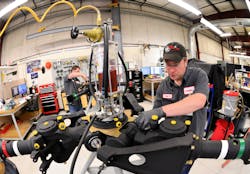Ready, Set, Go
Columbia Helicopters is the world’s largest owner/operator of the Columbia 234 Chinook, Columbia Vertol 107-II and Boeing CH-47D Chinook aircraft. The company services these aircraft tip to tail and has a distinct method for keeping them ready to fly.
“The way we maintain an operational readiness rate is a concerted focus on our platforms,” Michael Tremlett, vice president of business development for Columbia Helicopters, said. “We ensure we have an availability of parts, services and other resources to make sure the operational readiness rate stays around 90 percent. It’s a concerted effort on maintenance ensuring that we stay on top of our preventative maintenance checks and services, additional checks, and required maintenance.”
What sets Columbia Helicopters’ process apart from other companies is its focus on progressive phase maintenance over phased maintenance.
“Most operators are focused on a phased maintenance program,” Tremlett said. “To keep our fleet up and running we use progressive phase maintenance. It’s continuous maintenance so you’re not waiting until you hit a 200-hour or 400-hour phase program. We’re continuously executing phase maintenance to ensure we’re always ready and we’re ahead of the required heavy maintenance.”
“We take the phase program and we lay it out flat,” he continued. “We look at time sequential and what we need to do to meet all the heavy maintenance inspection gates. We then take the necessary corrective action, if any, as a result of those inspections. It’s a continuous process that runs every day throughout the year.”
Tremlett also attributes Columbia Helicopters’ 90 percent average operational readiness rate to its vertical integration. The entire maintenance program is self-sufficient since the company is the OEM for the Columbia 234 Chinook, Columbia Vertol 107-II and has a type certificate for the Boeing CH-47D Chinook. Instead of waiting for approval from a third party — which costs valuable time — Columbia Helicopters can simply authorize a repair itself.
The company’s extensive experience in aircraft maintenance also helps keep the average operational readiness rate high. Columbia Helicopters launched in 1957 and has since expanded to support commercial and military operations all over the world.
“In addition to the U.S. Army, we also have a long history of supporting foreign military with their sustainment needs. There’s the Australian Defense Force, the UAE, Egypt, the Netherlands, Greece, and others,” Tremlett said. “Essentially, every other foreign military that operates the CH-47D or CH-47F, we have the capability to support them with MRO services.”
Columbia Helicopters has experience supporting aircraft in high operational tempo situations; the company played a significant role in logistics support in Afghanistan, for example.
“We supported the Department of Defense with logistic support for the last 10 years and we had a significant operational tempo there,” Tremlett said. “On average our aircraft flew 200 hours per month per aircraft. That’s significantly more than the U.S. Army flies their aircraft per year.”
Tremlett said the Biden Administration’s withdrawal from Afghanistan affected Columbia Helicopters’ business, but the experience helped the company hone its craft.
“It was a very high-tempo environment so with the loss of those opportunities, it’s a downturn from that operational tempo,” he commented. “But that removed, we’re not dependent on the Department of Defense. So I think we’re in a very healthy place right now with other operational divisions that we have.”
“I served in Afghanistan while I was still in the military as an aviator and those environments, they come and go,” Tremlett continued. “I think it’s more of a good news story for Columbia Helicopters that we were able to rapidly surge into that environment and provide a very critical service to the Department of Defense. What it allowed us to do was really hone our craft by having to have the volume of aircraft and high readiness rate. We became very proficient in really maintaining a high operational readiness rate. And, if anything, that environment made us better for the environments we currently serve. It gave us better experience and better tools to help the rest of the industry.”
Columbia Helicopters’ experience, vertical integration, and unique maintenance schedule contribute to its 90 percent or more average operational readiness rate. The company aims for 100 percent average operational readiness rate but Tremlett said it’s nearly impossible to achieve because of planned and unplanned maintenance.
“Those things that are unscheduled and unplanned pop up,” he noted. “You might have something with a component. A seal ring or O ring goes bad. You can’t really anticipate when certain things happen like that but you can prepare for them. We have a support system in place for that operation where we account for what could go wrong as well as planned maintenance downtime. And so we quickly respond with piece parts and necessary resources to overcome whatever maintenance needs arise. It’s about having the right people and the right resources in place.”
Support Centers
Columbia Helicopters puts its expertise to use by providing its military and commercial customers with total logistics support for GE CT58/T58 engines. The company’s network of service centers give customers access to parts, technical publications, engineering support services, and test cell approvals for the engines. This network ensures military and commercial customers can reliably access options to keep their operational and logistical needs satisfied.
“To support the military and commercial customers on those platforms, we have established a network of service centers that are small MRO shops,” Tremlett said. “We work through those to reach our end customer.”
Columbia Helicopters also repairs and overhauls a range of related accessories including fuel controls, pumps and manifolds, centrifugal purifiers, flow dividers, oil coolers, bypass and relief valves and more. Tremlett said having these support centers help Columbia Helicopters readily assist its customers.
“You have to be completely customer-focused and instead of having a customer ship a part by air or by water, we forward project a service center into a region so it’s an immediate response to the needs of the customer.”
